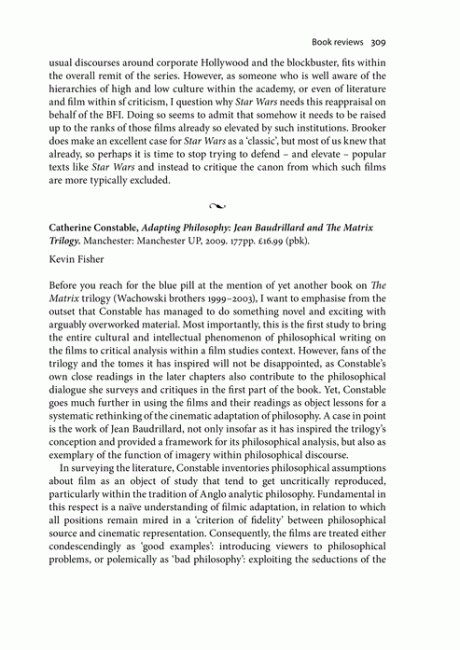Project MUSE – Adapting Philosophy: Jean Baudrillard and The Matrix Trilogy by Catherine Constable (review).
In lieu of an abstract, here is a brief excerpt of the content:
Before you reach for the blue pill at the mention of yet another book on The Matrix trilogy (Wachowski brothers 1999-2003), I want to emphasise from the outset that Constable has managed to do something novel and exciting with arguably overworked material. Most importantly, this is the first study to bring the entire cultural and intellectual phenomenon of philosophical writing on the films to critical analysis within a film studies context. However, fans of the trilogy and the tomes it has inspired will not be disappointed, as Constable’s own close readings in the later chapters also contribute to the philosophical dialogue she surveys and critiques in the first part of the book. Yet, Constable goes much further in using the films and their readings as object lessons for a systematic rethinking of the cinematic adaptation of philosophy. A case in point is the work of Jean Baudrillard, not only insofar as it has inspired the trilogy’s conception and provided a framework for its philosophical analysis, but also as exemplary of the function of imagery within philosophical discourse.
In surveying the literature, Constable inventories philosophical assumptions about film as an object of study that tend to get uncritically reproduced, particularly within the tradition of Anglo analytic philosophy. Fundamental in this respect is a naïve understanding of filmic adaptation, in relation to which all positions remain mired in a ‚criterion of fidelity’ between philosophical source and cinematic representation. Consequently, the films are treated either condescendingly as ‚good examples’: introducing viewers to philosophical problems, or polemically as ‚bad philosophy’: exploiting the seductions of the medium to indulge forms of sophistry. Constable provides an incisive analysis of the paradoxes and contradictions that eventuate, for example, in discussions of filmic adaptations of Baudrillard’s concept of the hyperreal, which contests the very relation between original and copy that the fidelity model presumes. Ironically, the ‚bad copy’ enacts a heightened fidelity to the source. Yet, as Constable points out, such ironies are not restricted to the attacks of analytic philosophers, but reach their apogee in Baudrillard’s own disqualification of the trilogy on the basis of infidelity to his thought. For Constable this point of tacit consensus among thinkers who would otherwise agree on little else is reflective of engrained philosophical hierarchies, such as conceptual/ perceptual, word/image and academic/popular within the fidelity model, and in relation to which the categorical incapacity of film as a medium to duplicate the forms of abstract argumentation characteristic of language gets misconstrued as a specific shortcoming of the trilogy. What Constable calls for instead is an inquiry into how philosophical thought gets reconstituted within the communicative structures specific to moving images, rather than lamenting that latter’s inability to form a syllogism.
The way forward, Constable argues, starts from an understanding that the key link between philosophical and filmic texts is not argumentation but figuration, which is crucial for articulating a more expansive sense of adaptation. The groundwork for such an approach is laid out in the second chapter by drawing formatively upon Kamilla Elliot’s work on the filmic adaptation of literature and Michèle Le Doueff’s analysis of the disavowed role of imagery within philosophical language. Considerable effort is spent tracing Elliot’s argument that while structuralist semiotics has broadened the notion of textuality to incorporate film and other image-based media, it still preserves a separation of graphic and iconic signs in relation to which thought gets excluded from the perception of images. Although Constable draws upon Elliot’s idea of a ‚looking-glass logic’, which emphasises the reversibility of the graphic/conceptual and linguistic/iconic modalities of signification, she rejects the notion that one must dispense with structural semiotics in favour of a cognitivist approach to articulate this reciprocity. She turns instead to the interrelation of metaphor and metonymy within Christian Metz’s cine-semiotics to challenge the separation of thought and perception within film experience. Her reading of Metz is insightful and draws attention to neglected aspects of his…




